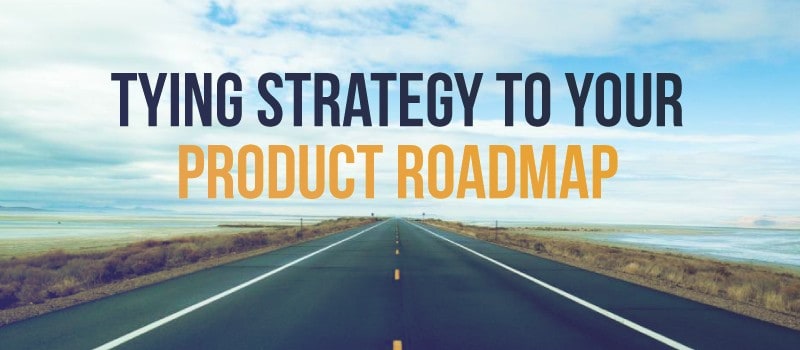We’ve all heard about “strategic” product roadmaps. But what exactly does that mean in practice?
A roadmap is a plan for your strategy that maps out the direction of your product. It provides context for your stakeholders and communicates the why behind what you’re building. Ideally, it’s a high-level visual summary that helps product managers get everyone on the same page.
A product roadmap isn’t simply a list of features or the backlog. The roadmap needs to communicate the big picture to the organization—the initiatives that move the needle, expand markets, address competition and create customer value. That big-picture thinking can’t be distilled in a list of features.
The Benefits of a Strategic Roadmap
Whether you believe roadmaps should be date-based, short-term or long-term, your roadmap needs to convey the strategic direction for your product. And it has to tie back to the strategy of the company.
A product roadmap has several ultimate goals.
- Describe your vision and strategy
- Provide a guide for executing the strategy
- Align internal stakeholders
- Facilitate discussion of options and scenario planning
- Communicate progress and status of product development
- Share your strategy with external stakeholders (including customers)
The most important part of the roadmap process happens before you begin building your roadmap. Setting the vision and strategic goals for the product—and, more importantly, getting alignment on these with your stakeholders—is the first step to creating a successful roadmap.
Top-Down Strategic Planning
Through hundreds of conversations with product managers, I have clearly seen that executives prefer top-down strategic planning and communication. They want to have productive discussions about future initiatives that tie directly to the product vision and goals.
They simply don’t care much about the details—what they really care about is whether the proposed roadmap fits with the strategic direction of the company and when its initiatives will be delivered to support the strategy.
Successful product managers keep the roadmapping strategy high-level. From there, they can derive the detailed release plan and backlog. Plus, by sharing a high-level product vision, you can get the executive team, marketing, support, engineering management and the rest of the organization on board with the strategy.
Explaining the Why
When developing a strategy that ultimately leads to a product roadmap, it’s important to identify and articulate your product’s vision and principles—the why.
Spend time before you begin planning your roadmap determining the product’s mission, and then distill it into a simple statement your stakeholders can understand. This statement should include the product vision, the problems it solves, target customers and value to the marketplace. Documenting this forces you to nail down many of the key items that will inform your roadmap.
This strategy-first approach has several benefits. It makes it easier to articulate the product vision to any constituency across your company, and ensure stakeholders are on the same page before you begin the detailed conversations that follow. It also allows you to more clearly identify priorities, as well as items that should be set aside because they don’t serve the product vision.
Defining Your Product Goals
From the product vision you can derive product goals that will in turn influence the initiatives that are on your roadmap. Coming up with these outcome-based objectives helps you translate your product strategy into an executable plan.
For example, if you are adding features for your customer’s’ shopping cart experience, you must be able to tie those features back to a specific strategic goal. For example, “improving satisfaction,” or “reduce shopping cart abandonment.”
Every organization’s product goals will be different but might include:
- Competitive differentiation
- Customer delight
- Technical improvements
- Sustain product features
- Improve customer satisfaction
- Increase lifetime value
- Upsell new services
- Reduce churn
- Expand geographically
- Mobile adoption
Goals can be general, but should be measurable as those tied back to metrics are the ones that resonate with stakeholders. Goals are often longer-term initiatives, changing annually rather than monthly, and can be product-specific, company-oriented or more generic. Many organizations are moving to an objectives and key results (OKR) system that communicates measurable results, helping teams focus on the right things.
Showing Strategy on the Roadmap
There are several ways you can communicate the strategy on the product roadmap.
Themes. Rather than listing individual features and tasks in your product roadmap, think bigger-picture and group them into themes. Themes are similar product features, epics or initiatives grouped together according to a larger, strategic objective they share. For example, “Customers Complete First Purchase Faster” might be a theme that would be tied back to a measurable strategic goal.
Metrics. Metrics are ideal for guiding your product decisions and your product roadmap. Business goals such as revenue, margin, acquisition cost and retention are a great way to tie roadmap initiatives to your strategy. Customer-specific metrics such as product usage and retention are important as well if those relate to your broader strategy.
Visual. Whether you use PowerPoint, a product roadmap template or product roadmap software, create a roadmap document that has impact. This means using color, or other means, to represent how your roadmap ties to strategic objectives. Keep it high-level. Remember that you are telling a story about how your strategy fits with the product vision. So tell the story in big, bold strokes rather than diving into the details.
Prioritization. Introduce strategy into your prioritization process as well. Evaluate bigger opportunities based on their value relative to their complexity to implement. Value could be exclusively customer value or a broader business value. The initiatives that have the highest value and the lowest effort will be the low-hanging fruit for your roadmap (and easier to get buy-in for).
It’s easy to add features to a roadmap. But to build compelling products your roadmap needs to be guided by strategy. Setting the vision and strategic goals for the product—and, more importantly, getting alignment on these with your stakeholders—is the first step to creating a successful roadmap.
Jim Semick is founder and chief strategist at ProductPlan, the leading provider of product roadmap software for product and marketing teams. For more than 15 years he has helped launch new products now generating hundreds of millions in revenue. He was part of the founding team at AppFolio, a vertical SaaS company. Prior to AppFolio, Jim validated and helped launch GoToMyPC and GoToMeeting (acquired by Citrix). Jim is a frequent speaker on product management and the process of discovering successful business models. He contributes at www.productplan.com/blog. Follow Jim at https://twitter.com/jimsemick.
To learn more about roadmapping, read the Product Roadmaps issue of Pragmatic Marketer.
Author
-
Jim Semick is co-founder of ProductPlan, a leading provider of cloud-based roadmap software for product and marketing teams. For more than 15 years he has helped launch new products now generating hundreds of millions in revenue. He was part of the founding team at AppFolio, a vertical SaaS company. Prior to AppFolio, Jim validated and created version 1.0 product requirements for GoToMyPC and GoToMeeting (acquired by Citrix). Jim is a frequent speaker on product management and the process of discovering successful business models. He contributes at www.productplan.com/blog. Follow Jim on Twitter at @JimSemick.
View all posts









